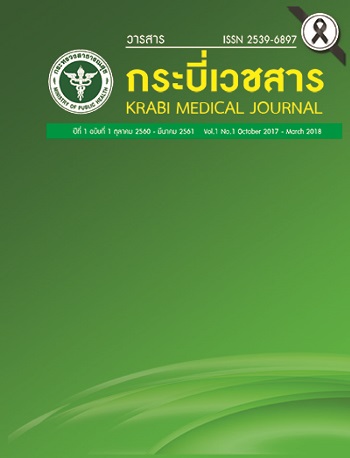Research into Pesticide Applications Behavior and Cholinesterase Levels of Staff in Garden Handling Department of Palm Oil Company; Krabi Province
Main Article Content
Abstract
This descriptive research is aimed to find out the behavioral patterns of pesticide use and cholinesterase levels after pesticide uses of the workers in garden handling deparement, Palm Oil company,
Krabi Province.
Matarials and methods : All Subjects were assessed the risk of perticide exposure by application form for farm workers, in addition, cholinesterese level was estimated by the testing kit (Reactive paper). Statistical analysis was described by frequency and percentage of each factor.
Result : Overall participants compose of 87 subjects, those are mostly female (70%) age 31 - 51 years (66.7%), 57.5% of perticide users are also prepare the mixture themselves. Frequent uses more than 7 days/month is 51.7%. About behavioral patterns, most subjects read the instruction before usage (79%), protect themselves with rubber gloves (88.9%), use well-sealed pesticide containers during spraying (74.7%),
but some of them (51.7%) have food consumption in working areas. After pesticide usage, 48.3% of subjects
change their contaiminated clothes. The cholinesterase are risky levels in most subjects (83.9%) and
level is 10.3%.
Conclusion : Most of pesticide workers have risky and hazardous levels of cholinesterese, so the suggestions should be preventive traning programs of proper posticide use, pesticide hazard, posioning after working. Furtherrmore monitoring programs should be provided for risk assessment proventing pesticide illness.
Article Details
บทความนิพนธ์ต้นฉบับจะต้องผ่านการพิจารณาโดยผู้ทรงคุณวุฒิที่เชี่ยวชาญอย่างน้อย 2 ท่าน แบบผู้ทรงคุณวุฒิ และผู้แต่งไม่ทราบชื่อกันและกัน (double-blind review) และการตีพิมพ์บทความซ้ำต้องได้รับการอนุญาตจากกองบรรณาธิการเป็นลายลักษณ์อักษร
ลิขสิทธิ์
ห้ามนำข้อความทั้งหมดหรือบางส่วนไปพิมพ์ เว้นว่าได้รับอนุญาตจากโรงพยาบาลเป็นลายลักษณ์อักษร
ความรับผิดชอบ
เนื้อหาต้นฉบับที่ปรากฏในวารสารเป็นความรับผิดชอบของผู้เขียน ทั้งนี้ไม่รวมความผิดพลาดอันเกิดจากเทคนิคการพิมพ์
References
2. สุนิสา ชายเกลี้ยง และสายชล แปรงกระโทก. การประเมินทางชีวภาพ ด้านความเสี่ยงต่อการสัมผัสสารเคมีกำจัดศัตรูพืชในกลุ่มเกษตรกร ผู้ทำนา: กรณีศึกษาตำบลแก้งสนามนาง อำ เภอแก้งสนามนาง จังหวัดนครราชสีมา. ศรีนครินทร์เวชสาร 2556;28:382-9.
3. สำนักโรคจากการประกอบอาชีพและสิ่งแวดล้อม กรมควบคุมโรค. องค์ความรู้ด้านการก่ออันตรายของสารกำจัดศัตรูพืชที่ต้องเฝ้าระวัง. กรุงเทพมหานคร : กระทรวงสาธารณสุข; 2556.
4. สำนักโรคจากการประกอบอาชีพและสิ่งแวดล้อมกรมควบคุมโรค. รายงานสถานการณ์โรคและภัยสุขภาพจากการประกอบอาชีพและสิ่งแวดล้อม ปี 2558. กรุงเทพมหานคร: กระทรวงสาธารณสุข; 2558.
5. สำนักโรคจากการประกอบอาชีพและสิ่งแวดล้อม. โรคจากการประกอบอาชีพภาคเกษตร [อินเทอร์เน็ต]. [เข้าถึงเมื่อ 5 ต.ค. 2559]. เข้าถึงได้จาก: http://envocc.ddc.moph.go.th/contents/view/106.
6. ตั้ม บุญรอด และวิชชาดา สิมลา. พฤติกรรมการใช้สาร กำจัดศัตรูพืชของเกษตรกรในตำบลแหลมโตนด อำเภอควนขนุน จังหวัดพัทลุง. วารสารมหาวิทยาลัย ทักษิณ 2554;14:66-75.
7. กฤติญา แสงภักดี และคณะ. การศึกษาพฤติกรรมการใช้สารเคมีในการกำจัดศัตรูพืชของชาวนา อำเภอองครักษ์ จังหวัดนครนายก. แก่นเกษตร 2557; 42:375-84.
8. สำนักงานสถิติจังหวัดกระบี่. รายงานวิเคราะห์สถานการณ์จังหวัดกระบี่ 2559. กระบี่: กระทรวงเทคโนโลยีสารสนเทศและการสื่อสาร; 2559.
9. สำนักโรคจากการประกอบอาชีพและสิ่งแวดล้อมกรมควบคุมโรค. องค์ความรู้เกี่ยวกับการตรวจคัดกรองความเสี่ยงจากการสัมผัสสารเคมีกำจัดศัตรูพืชโดยกระดาษทดสอบโคลีนเอสเตอเรส (Cholinesterase reactive paper) สำหรับเจ้าหน้าที่สาธารณสุขในหน่วยบริการสุขภาพปฐมภูมิ. กรุงเทพมหานคร : กระทรวงสาธารณสุข; 2558.
10. ณัฐพร ปลื้มจันทร์ และณิชชาภัทร ขันสาคร. ปัจจัยที่มีความสัมพันธ์กับระดับเอนไซม์โคลีนเอสเทอเรสในเลือดของเกษตรกรใน ตำบลเกาะจันทร์ อำเภอเกาะจันทร์ จังหวัดชลบุรี. วารสารพิษวิทยาไทย 2558; 30(2):128-141.


